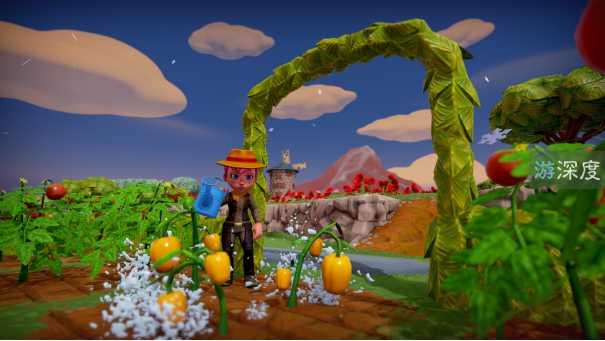
大暑,夏季的最后一个节气,唯愿晴日朗照,人间皆安。
转眼已到了大暑节气
这几天
大家都在为河南的灾情焦心
守望相助之余
我们深深盼望暴雨赶快停息
阳光灿烂重新到来
二十四节气中的中华文化之大暑(中文版)
大暑
作者:刘辰
大暑是二十四节气中的第十二个节气,
也是夏季的最后一个节气。
“小暑不算热,大暑正伏天”,
大暑前后,是一年中阳气至盛,最为炎热的时节。
热,是一种身体的体验。
画家们将身体的感觉转化为情感思维的记忆,
最终呈现为艺术的表达。

夏(中国画)李小可
李小可的作品《夏》中,
林荫道旁的老树在空中交结缠抱,为行人遮蔽酷暑,
但浓密的叶子却被毒辣的阳光“融化”着,绿作一团。
林荫道的尽头,是一团似近似远的留白,
不禁让人联想到“白热”一词。
作者将物理现象转变为色彩语言,
使画作多了几分感官上的冲击力。

夏日(版画)李聪玲
在作品《夏日》中,李聪玲同样用树林和树荫诠释着“热”的主题。
画面明暗交错,
在阳光的暴晒下,树叶仿佛被烤干,泛黄发脆,
树荫下,绿色的地衣悄无声息地内卷,露出斑驳的黄土块。
一股盛夏的暑气,
似乎从画中细密的笔触和版画特有的干燥感中蒸腾而出,弥散无声。

荷不畏暑(中国画)韩天衡
韩天衡的《荷不畏暑》,画的是荷塘一角的别样风韵。
画家充分发挥中国画水墨氤氲的效果,
将荷叶在酷暑中的身姿,动态传神地表现出来,夸张却不跳脱。
荷叶用色大胆,让观者在色差中体验到温差,
夏日的焦灼感油然而生。

大暑(中国画)戴树良
自然之外,大暑时节的人间烟火也是画家们喜爱的主题。
谢兴涛以苏轼“人生十六乐事”为题,创作《暑至临溪濯足》,
画中古人宽衣解带,濯足于柳下,
与仙鹤隔岸对视,妙趣横生;
戴树良的作品《大暑》则以当代田园为背景,
画中儿童与水牛嬉于水中,憨态可掬,
远处农人依稀,戴笠耕种,
稼穑之苦与田园之趣交织,朴实感人。
关于大暑,一些有趣的消夏方式在民间流传至今,
如吃仙草、扑流萤等等。
这些民俗与文艺创作一起,记述着中国人对“热”特有的民族记忆。
二十四节气中的中华文化之大暑(英文版)
Da Shu
Da Shu, also named Greater Heat, is the 12th of the 24 solar terms, and it is the hottest time in the year. As an old Chinese saying goes, “In Xiao Shu (Lesser Heat), it is not hot enough, while in Da Shu, it is really hot.”
Heat is a physical experience. In depicting heat, painters transform the feeling of the body into emotional reflection and presents it in an artistic way.
In Summer, a painting by Li Xiaoke, we see old trees with their branches entangled standing along the boulevard, forming a canopy shielding pedestrians from the scorching heat. Their dense leaves are almost melted by the strong sunlight, turned into a body of thick greenness. At the end of the boulevard, there is a white space, which reminds of a phrase – "white heat". The painter thus transforms a physical phenomenon into colors and create a vivid visual impact.
In A Summer Day, a print, the painter Li Congling also depicts the theme of heat with trees and shade. The painting is a mixture of light and shade. In the sunlight, the leaves are dry, yellowish, and brittle. In the shade of trees, the green moss rolls back, revealing clods of yellow soil. The summer heat seems to flow from the brushstrokes of the painting and dryness peculiar to prints, and diffuse quietly.
Han Tianheng's traditional Chinese painting "Heat Defying Lotus" depicts the charm of a lotus pond in summer. Employing the splash technique of traditional Chinese painting, the painter vividly presents the vibrant lotus leaves in the heat in a bold yet not exaggerated way. The strong green color of lotus leaves enables the viewer to experience the summer heat through contrast of colors.
Apart from natural scenes, human activities during Dashu are also a favorite theme of painters. Drawing inspiration from a poem by Su Shi, a famous Song Dynasty poet in the 11th Century, Xie Xingtao produced a painting entitled "Washing Feet in the Stream in Summer". It is a lively scene of one washing his feet under the willows, watched by the crane across the stream.
In Greater Heat, a painting by Dai Shuliang, children and buffaloes are playing in the water. In the distance, several people, wearing bamboo hats, are working in the field. The painting presents an idyllic rural scene of both pleasure and hard work.
Many old ways of spending summer during Dashu remain popular today, such as eating herbal jelly and chasing fireflies. These artistic creations as well as folk customs are special ways in which the Chinese spend a hot summer.
盛夏光年 万物荣华
盼晴日朗照,一切安好
经历挫折 克服困难
我们将以更坚定的姿态前行
也一定会等来丰收的秋天
文字素材来源:光明日报
出品:光明日报&中国传媒大学
来源: 光明网
,




